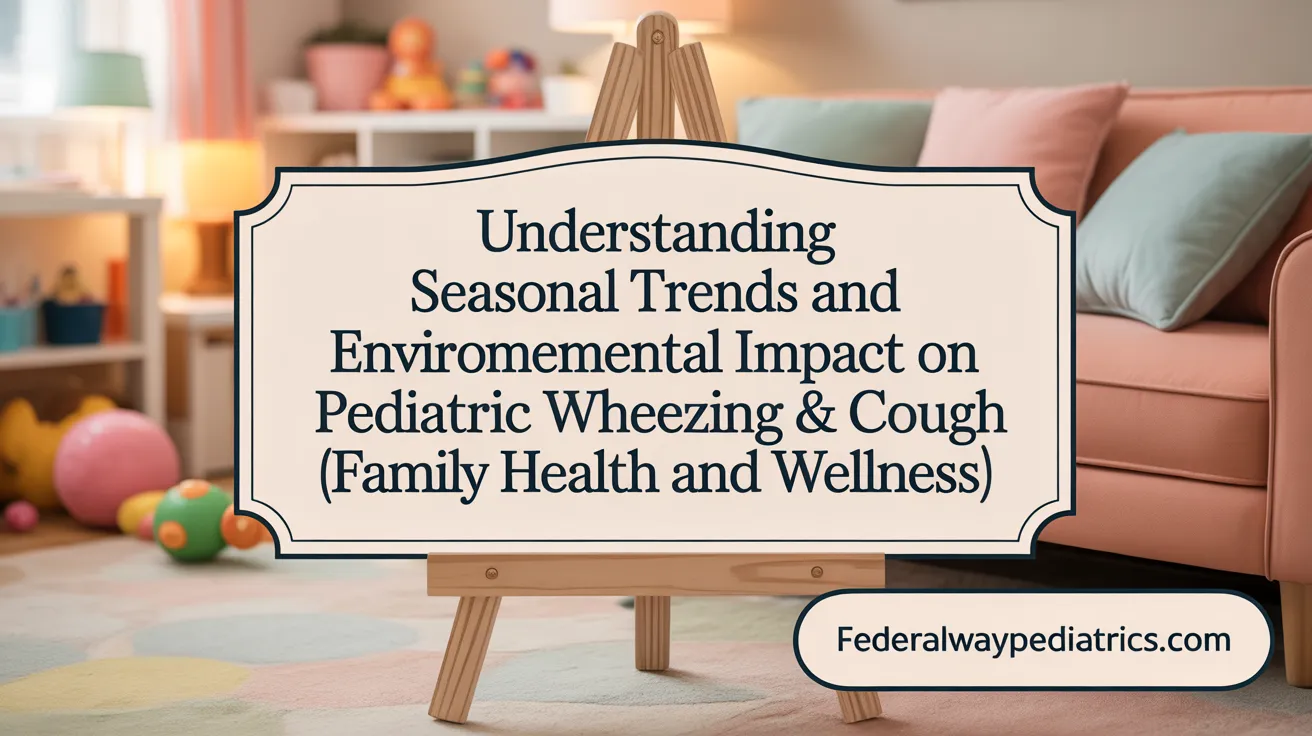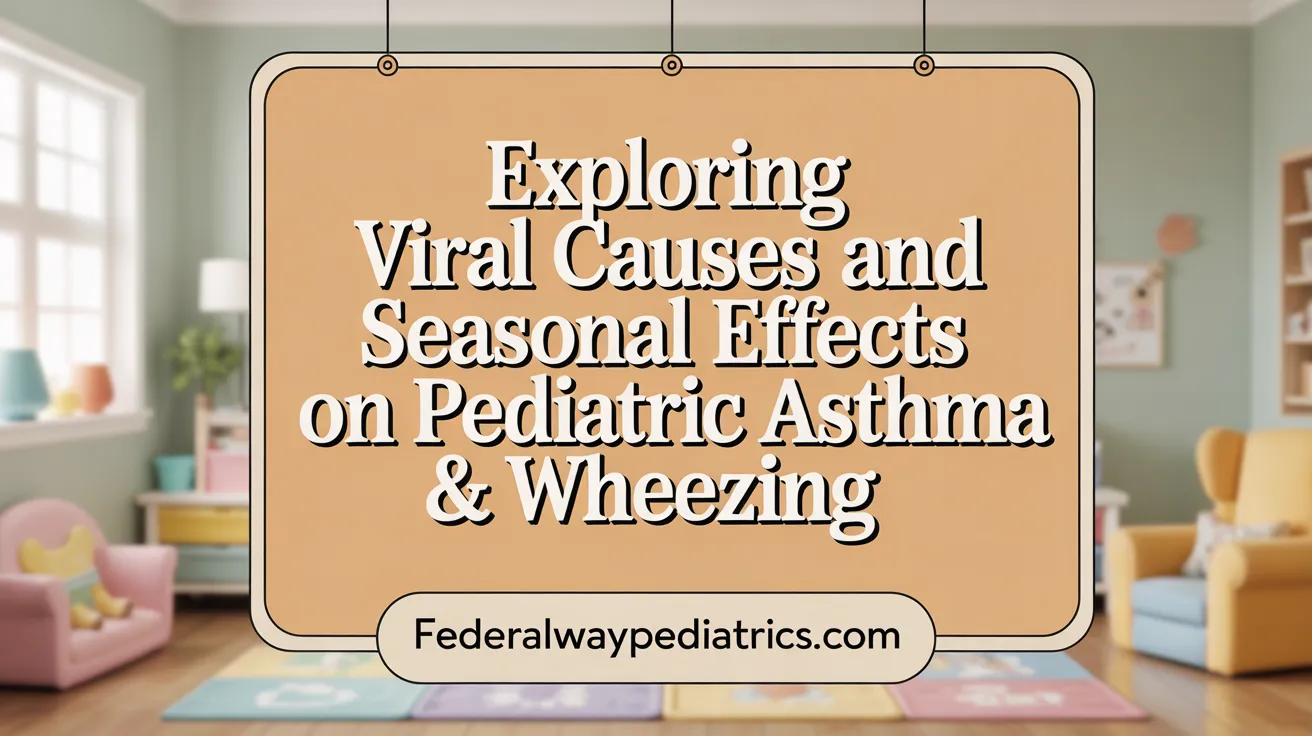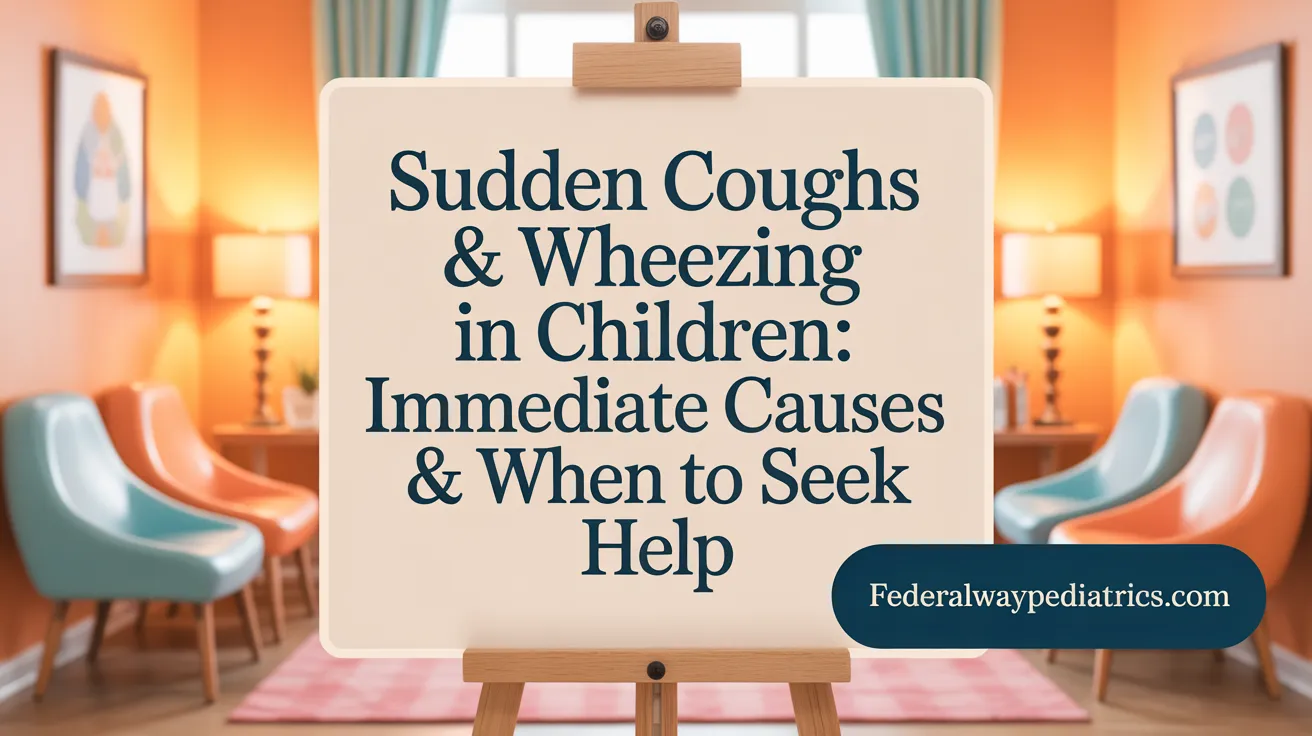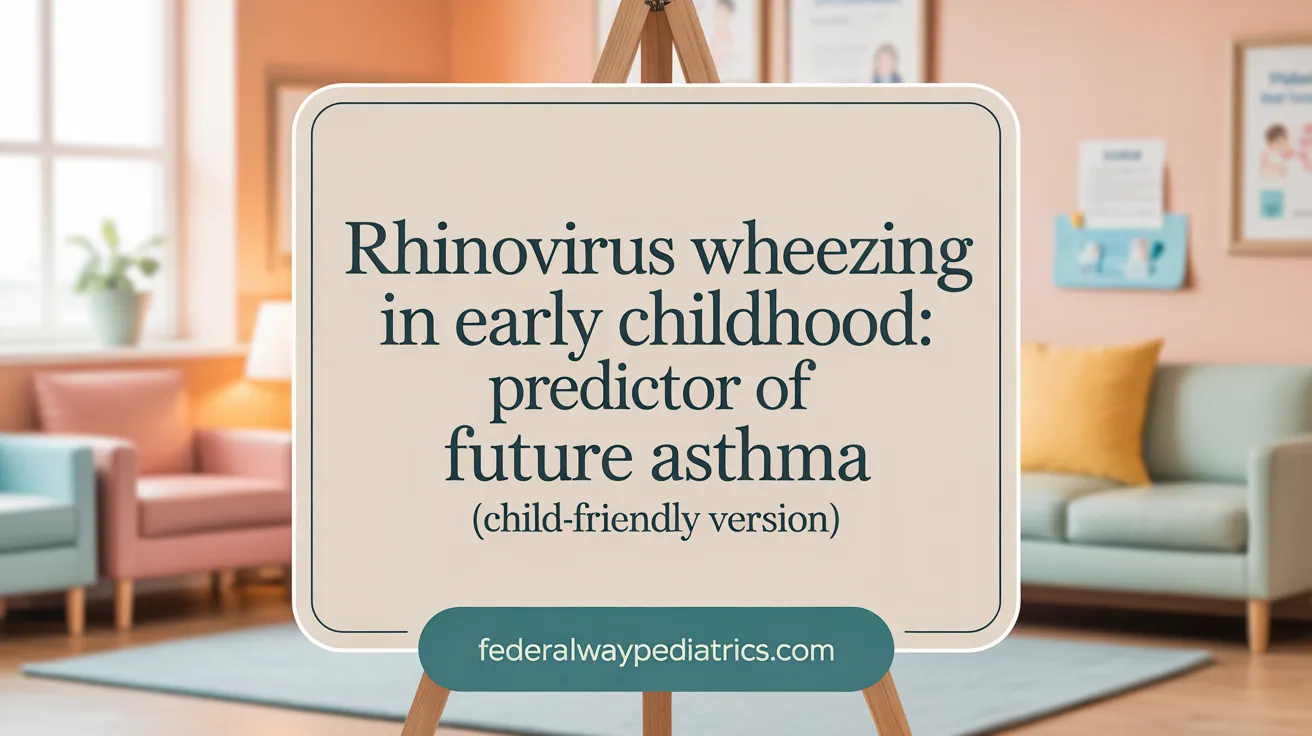Introduction to Pediatric Respiratory Symptoms and Seasonal Dynamics
Cough and wheezing are common respiratory symptoms seen in children, often signaling underlying diseases such as asthma or infections like bronchiolitis. Understanding the causes and seasonal trends of these conditions is critical for timely diagnosis, effective management, and planning public health interventions. This article explores comprehensive data and scientific research illuminating the multifaceted causes, seasonal variations, environmental influences, and epidemiological patterns of pediatric cough and wheezing, helping caregivers and clinicians navigate this complex clinical landscape.
Key Facts on Pediatric Wheezing and Cough Influences
- Most pediatric wheezing peaks in winter, with regional variations such as fall in Virginia and November in Arizona.
- Colder temperatures are strongly associated with higher wheezing and hospitalization rates in children.
- Environmental pollutants like PM2.5, NO2, and SO2 significantly exacerbate respiratory illnesses in children.
- Over 50% of children experience wheezing before age 6, mainly due to viral infections like RSV and rhinovirus.
- Climate change leads to longer pollen seasons and more extreme weather, worsening pediatric respiratory health.
- Temperature negatively correlates with hospitalization rates, colder conditions increase risk, with humidity affecting pollutant and mold growth.
- Predictive ARIMA models using climate data can forecast wheezing cases, aiding early healthcare responses.
- RSV, HRV, and Mycoplasma pneumoniae are primary viral causes of wheezing in children, with RSV most prevalent.
- Early rhinovirus wheezing strongly predicts future asthma development, especially in high-risk children.
- Public health measures like social distancing reduced asthma exacerbations during COVID-19, but lifts in restrictions caused resurgent peaks.
1. Seasonal and Environmental Influences on Pediatric Wheezing and Cough: Epidemiological Data and Climate Impact

What are the seasonal peaks and trends of wheezing and cough in children?
Research indicates that pediatric wheezing diseases often follow seasonal patterns influenced by viral infections and allergens. Most cases of wheezing occur during winter, with a significant peak in winter months such as December to February, and a secondary increase in late fall, particularly around November. These patterns are region-specific; for example, in Charlottesville, Virginia, the peak occurs in fall, while children in Tucson and Yuma, Arizona, also see invites in November. Furthermore, in southern regions like New Orleans, increased exacerbations start in September and persist throughout the school year, whereas in some areas, activity diminishes in summer. Cough prevalence in children shows a similar pattern, with acute cough mostly caused by upper respiratory infections like colds and bronchitis, and chronic cough often related to asthma or recurrent infections lasting over a month.
How do meteorological factors influence respiratory symptoms in children?
Meteorological conditions significantly impact respiratory health. Lower temperatures are strongly associated with higher rates of wheezing and hospitalizations in children with respiratory diseases. Studies reveal a negative correlation between average temperature and wheezing prevalence, with colder months fostering increased symptoms (P<0.001, r=−0.598). Humidity and rainfall also influence disease patterns; for instance, increased rainfall can promote mold growth, which is a known trigger for asthma exacerbations. Conversely, higher temperatures and dry conditions tend to reduce indoor dampness and mold but may increase pollen levels, affecting allergic reactions. Additionally, extreme weather events like thunderstorms can trigger asthma attacks through sudden changes in airquality and allergen dispersal.
What role do environmental pollutants play in exacerbating pediatric respiratory illnesses?
Environmental pollutants, including PM2.5, PM10, NO2, SO2, and CO, are strongly linked to increased hospital admissions and severity of wheezing and asthma episodes among children. Higher pollutant levels, especially during heatwaves and stagnant air conditions, exacerbate respiratory inflammation and airway hyperreactivity. Synergistic effects have been observed between pollen and pollution; for example, ozone and particulate matter can amplify allergic responses, intensifying asthma symptoms. Indoor exposure to pollutants like tobacco smoke and mold spores further contributes to worsening airway inflammation and exacerbations. Vulnerable children with pre-existing conditions become more susceptible during high pollution periods, underscoring the importance of pollution control in pediatric respiratory health.
What epidemiological statistics shed light on wheezing diseases and their seasonal variability?
Large-scale epidemiological data reveal that more than 50% of children experience wheezing before age 6, primarily due to lower respiratory tract infections caused by pathogens such as respiratory syncytial virus (RSV, 21.35%), human rhinovirus (16.28%), and mycoplasma pneumoniae (10.47%). Infants under 12 months are most affected, accounting for over 58% of wheezing cases. Hospitalization data from 2005 to 2009 involving 919,873 children show pronounced seasonal variations, with asthma exacerbations peaking in September, especially among children aged 2–5 years, correlating with school reopening. The timing of peaks varies geographically but consistently indicates higher activity during colder months, reinforced by increased viral activity and allergen exposure.
How does climate change influence respiratory health in children?
Climate change affects pediatric respiratory health through multiple pathways. Increased pollen concentrations and extended pollen seasons lead to higher sensitization rates, especially among children with allergic asthma. Extreme weather events like heatwaves and cold spells are associated with increased exacerbations and emergency visits. Wildfires, intensified by climate change, emit vast amounts of PM2.5, worsening respiratory conditions, particularly in vulnerable populations. Furthermore, increased rainfall, storms, and flooding promote mold growth, which can trigger asthma attacks. Rising pollution levels, especially ozone and particulate matter during heatwaves, further aggravate respiratory issues. Children’s physiology — including higher ventilation rates, outdoor activity, and mouth breathing — increases their exposure, placing them at heightened risk for climate-related respiratory complications.
What is the relationship between temperature, humidity, and hospitalization for respiratory conditions?
Temperature and humidity are vital factors influencing respiratory disease patterns. As temperatures decrease, the incidence of wheezing and asthma exacerbations increases. A study demonstrated a negative correlation between average temperature and asthma hospitalizations in children, with colder conditions raising the risk substantially. Humidity can also affect pollutant dispersal and mold growth indoors, impacting respiratory health. Rainfall and wind contribute to the distribution of allergens and airborne pollutants. Modeling techniques, such as ARIMA (AutoRegressive Integrated Moving Average), utilizing temperature data, have been effective in forecasting monthly wheezing cases, enabling early interventions and resource planning.
How are predictive models applied to anticipate cases of pediatric wheezing?
Predictive modeling, particularly ARIMA models incorporating meteorological data, has emerged as a valuable tool for forecasting respiratory disease outbreaks. For instance, models trained on temperature data can accurately predict increases in wheezing and asthma exacerbations a month in advance. This allows healthcare providers and public health agencies to prepare for potential surges in hospital visits and implement preventive measures. Seasonal and climate variables included in these models improve their accuracy and utility, especially in regions with distinct climate patterns. Ultimately, such forecasting strategies support targeted interventions, resource allocation, and public warnings, reducing the burden of pediatric respiratory illnesses.
2. Viral Etiology and Disease Mechanisms Behind Pediatric Asthma and Wheezing: Research on Causes and Seasonal Variations

What viral pathogens are linked to pediatric wheezing and asthma?
Respiratory syncytial virus (RSV), human rhinovirus (HRV), and Mycoplasma pneumoniae are major pathogens associated with wheezing in children. RSV is responsible for approximately 21.35% of cases, while HRV accounts for about 16.28%, and Mycoplasma pneumoniae around 10.47%. RSV, in particular, is a leading cause of acute lower respiratory infections, causing millions of hospitalizations and contributing significantly to childhood morbidity and mortality worldwide.
How do patterns of asthma exacerbations relate to viral infections and school re-entry?
Seasonal peaks of pediatric asthma exacerbations often coincide with viral outbreaks, notably in early fall and late winter. During the first COVID-19 year, a notable shift occurred, with a significant decline in respiratory emergency visits (40%) and hospitalizations (54-73%), reflecting the impact of public health measures like social distancing.
However, an unusual peak in asthma and wheezing-related emergency department (ED) visits and hospitalizations was observed in June 2020, shortly after lifting lockdown measures. This peak mirrored the typical
Understanding Asthma and Its Rising Prevalence in Children

What is asthma and why are the numbers of children with this condition increasing?
Asthma is a chronic respiratory disease characterized by inflammation and swelling of the airways, which leads to narrowing of the passages that carry air to the lungs. This causes symptoms such as wheezing, coughing, shortness of breath, and chest tightness. In children, these symptoms can vary in intensity and frequency, and severe attacks represent a medical emergency.
Over recent decades, the prevalence of asthma among children has been rising globally. Several factors contribute to this trend. Environmental pollution, including increased levels of particulate matter (PM2.5 and PM10), nitrogen dioxide (NO2), sulfur dioxide (SO2), and ozone, play significant roles. These pollutants irritate the airways and exacerbate asthma symptoms, especially during extreme weather events such as heatwaves and cold spells.
Additionally, lifestyle and societal changes influence this rise. Reduced exposure to infections in early childhood, due to cleaner environments and fewer siblings or outdoor activities, may impair immune development, leading to higher susceptibility to allergic diseases like asthma. Decreased rates of breastfeeding, which provide immune benefits, are also linked to increased allergy and asthma risk.
Genetic predisposition is another critical factor. Children with a family history of asthma or allergies are more likely to develop the condition. Socioeconomic factors, including living conditions and access to healthcare, further impact diagnosis and management.
Environmental allergens such as pollen, mold spores, dust mites, and pet dander have become more prevalent or more allergenic due to climate change and urbanization. Extended pollen seasons and higher pollen concentrations increase sensitization among children.
In summary, the increase in childhood asthma is caused by a complex interplay of genetic, environmental, and societal factors. Improved detection and awareness have also contributed to higher reported cases, reflecting both true prevalence and better diagnosis.
| Factor | Contribution | Description |
|---|---|---|
| Air Pollution | Major | Increased particulate matter and gases irritate airway lining |
| Environmental Allergens | Significant | Longer pollen seasons, mold growth, dust mite proliferation |
| Lifestyle Changes | Contributing | Less microbial exposure, reduced breastfeeding, urbanization |
| Genetic Factors | Innate | Family history of asthma and allergies |
| Climate Change | Amplifying | Extends allergen seasons, increases extreme weather events |
Understanding these factors helps in developing strategies to prevent and manage asthma in children, aiming to reduce its rising prevalence and impact.
Common Causes and Differential Diagnoses of Wheezing in Children
What is the most common cause of wheezing in children?
The leading cause of wheezing among pediatric patients is asthma. This chronic respiratory disease involves inflammation and swelling of the airways, leading to narrowing that makes breathing difficult. The characteristic whistling sound, or wheeze, occurs due to airflow limitation during exhalation. In infants and young children, viral infections such as bronchiolitis—mainly caused by respiratory syncytial virus (RSV)—are also common causes of wheezing episodes. These infections cause temporary airway swelling and mucus build-up. Other factors that can cause wheezing include aspiration of foreign objects, allergic reactions, and structural airway anomalies. Proper diagnosis is critical, as it helps in tailoring treatment plans aimed at reducing airway inflammation and preventing attacks.
Why Children Suddenly Cough and Wheeze: Common Immediate Causes

Why does my child suddenly cough and wheeze?
Sudden episodes of coughing and wheezing in children are common signs that something is irritating or narrowing their airways. Several causes can lead to these symptoms, especially in young children.
One common reason is respiratory infections like the common cold, bronchiolitis caused by respiratory syncytial virus (RSV), or influenza. These infections cause inflammation in the airway linings, making it harder for air to pass through and triggering wheezing and coughing.
Allergic reactions also play a significant role. Exposure to pollen, mold spores, dust, pet dander, or other environmental allergens can provoke an allergic response, leading to airway swelling, wheezing, and coughing. In children prone to allergies or asthma, even minor exposures can result in sudden symptoms.
Sometimes, a foreign object inhaled into the airways can cause immediate coughing and wheezing. This is especially common in younger children who tend to put small objects in their mouths.
Severe cases like croup, which often occurs in young children, are characterized by a barky cough and noisy breathing due to swelling in the voice box (larynx). Whooping cough (pertussis), though less common due to vaccination, also causes intense coughing spells followed by a 'whooping' sound.
It’s important to recognize symptoms that may indicate serious issues. Difficulty breathing, bluish lips or face (cyanosis), or a cough that lasts more than a week should prompt immediate medical evaluation.
Monitoring these episodes involves noting the frequency, duration, and associated symptoms like rapid breathing, chest retractions, or lethargy. Supportive measures—such as humidified air, keeping the child hydrated, and avoiding known irritants—can provide relief.
However, persistent or severe episodes require prompt evaluation by healthcare professionals. Proper diagnosis is essential to determine if the child has asthma or another condition that needs specific treatment.
Understanding these causes helps caregivers respond appropriately and seek timely medical attention when necessary, ensuring children receive the right care to manage their symptoms effectively.
Rhinovirus Wheezing Illnesses as Predictors of Asthma Development

Do wheezing rhinovirus illnesses in early life predict asthma development in high-risk children?
Rhinovirus-induced wheezing in early childhood plays a significant role in predicting the subsequent onset of asthma. Extensive longitudinal research has demonstrated a strong association between early wheezing episodes caused by rhinovirus and an increased likelihood of developing asthma during later childhood. This is particularly evident in children who are considered high-risk, such as those with a family history of asthma, atopic conditions, or other genetic predispositions.
Children experiencing rhinovirus-related wheezing episodes within their first few years are markedly more susceptible to being diagnosed with asthma by the time they reach school age than those with other viral illnesses or without early wheezing symptoms. Studies suggest that rhinovirus may contribute directly to structural changes in the airways, leading to airway remodeling that predisposes children to persistent asthma. Alternatively, frequent rhinovirus infections may simply mark an inherent vulnerability in these children’s immune or airway responses.
While not every child with early rhinovirus wheezing will develop asthma, these episodes are among the most potent indicators for future respiratory disease. Recognizing this pattern allows healthcare providers to identify children at elevated risk early on. Such early identification offers opportunities for targeted monitoring and potentially preventative interventions, which could delay or even prevent the progression to chronic asthma.
In clinical practice, children presenting with wheezing during rhinovirus infections—especially severe or recurrent episodes—should be carefully evaluated and monitored. Considering their heightened risk, early lifestyle modifications, environmental control, and possibly preventive pharmacotherapy could reduce the severity or delay the onset of persistent asthma, ultimately improving long-term respiratory health outcomes.
Summary and Future Directions in Managing Pediatric Respiratory Symptoms
The collective body of research and epidemiological data clearly highlights the multifactorial nature of cough and wheezing in children, driven by viral infections, environmental influences, and underlying chronic conditions like asthma. Seasonal trends demonstrate distinct peaks influenced by climatic factors and social behaviors such as school attendance, which shape patterns of respiratory exacerbations. Moreover, emerging insights into disease phenotypes and viral etiologies improve understanding and guide targeted management strategies. Climate change poses evolving risks by exacerbating respiratory triggers, underscoring the importance of adaptive and mitigation interventions. Recognizing these patterns enables clinicians, caregivers, and policymakers to better anticipate, prevent, and treat childhood respiratory illnesses, ultimately improving health outcomes for this vulnerable population.
References
- Unforeseen changes in seasonality of pediatric respiratory illnesses ...
- Association of children wheezing diseases with meteorological and ...
- Seasonality of Asthma: A Retrospective Population Study | Pediatrics
- Climate change and children's respiratory health - ScienceDirect.com
- A comparison of seasonal trends in asthma exacerbations among ...
- Asthma Facts
- Treating asthma in children under 5 - Mayo Clinic
- Patterns of Respiratory Symptoms and Asthma Diagnosis in School ...
